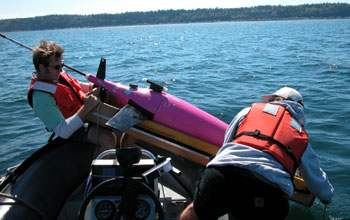Multimedia Gallery
Underwater Gliders for Ocean Climate Observations (Image 1)
Underwater Gliders for Ocean Climate Observations (Image 1)
Recovery of Seaglider S/N 008 after a test deployment in Port Susan, Wash. This vehicle swam over 2000 kilometers through the Labrador Sea on its subsequent deployment. Autonomous undersea vehicles enable oceanographers to measure hydrographic, chemical and biological indicators on long sections across the oceans.
The specific mission in these images was supported by the Office of Naval Research, although the development and fabrication of the equipment shown was supported by the National Science Foundation under grant OCE 99-11037. (Date of Image: July 29, 2003) [One of three related images. See Next Image.]
More about this Image
Owned by the University of Washington, Seaglider is one of several autonomous undersea vehicles that enable oceanographers to measure hydrographic, chemical and biological indicators on long sections across the oceans. They relay data ashore within hours of collection and can be controlled globally via the internet.
Seaglider is one of three gliders currently in operation and available for purchase; the other two are owned by Scripps and Woods Hole. Seagliders are small (about 50 kilograms) and can easily be handled by 2 people, making them ideal to take onboard vessels for research out at sea.
Underwater gliders are buoyancy-powered and glide slowly (~0.5 kilometers) along saw-tooth path trajectories through the ocean. They trade speed for range and endurance: halving speed doubles range and quadruples endurance, a result of the quadratic drag law.
Credit: Jason Gabot, University of Washington
Images and other media in the National Science Foundation Multimedia Gallery are available for use in print and electronic material by NSF employees, members of the media, university staff, teachers and the general public. All media in the gallery are intended for personal, educational and nonprofit/non-commercial use only.
Images credited to the National Science Foundation, a federal agency, are in the public domain. The images were created by employees of the United States Government as part of their official duties or prepared by contractors as "works for hire" for NSF. You may freely use NSF-credited images and, at your discretion, credit NSF with a "Courtesy: National Science Foundation" notation.
Additional information about general usage can be found in Conditions.
Also Available:
Download the high-resolution JPG version of the image. (2.8 MB)
Use your mouse to right-click (Mac users may need to Ctrl-click) the link above and choose the option that will save the file or target to your computer.



